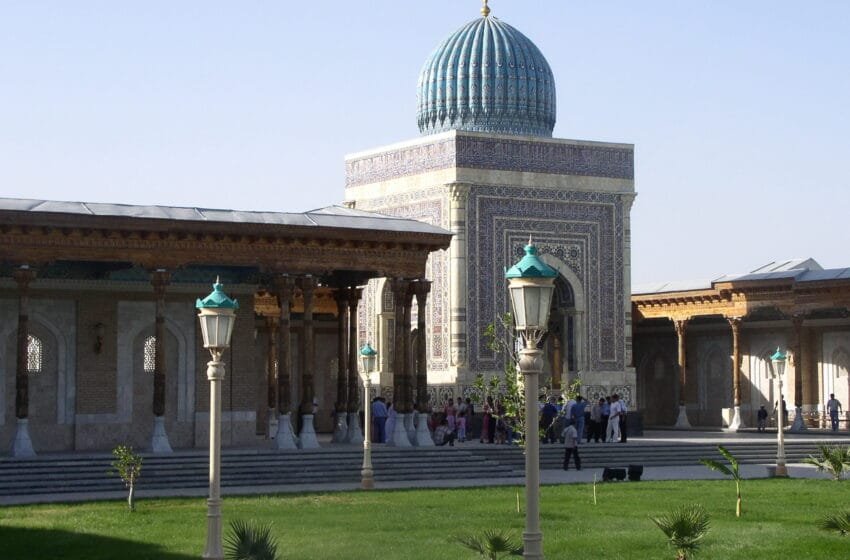The Memorial Complex of Imam Al-Bukhari: A 9th-Century Symbol of Islamic Heritage Restored in 1998

The Memorial Complex of Imam Al-Bukhari
The Memorial Complex of Imam Al-Bukhari (Imom Al-Buxoriy majmuasi) stands as one of the most revered Islamic cultural and spiritual landmarks in Uzbekistan. Located in the village of Hartang, Payaryk District, in the Samarkand region, this monumental complex commemorates the life and legacy of Imam Abu Abdullah Muhammad ibn Ismail Al-Bukhari. Built between 1997 and 1998, the site was established under the initiative of the first President of Uzbekistan, Islam Karimov, to mark the 1225th anniversary of Imam Al-Bukhari’s birth, according to the lunar calendar.
Historical Background
Early Years and Legacy
In 870 CE, Imam Al-Bukhari, exiled from Bukhara, was laid to rest in the modest cemetery of Hartang. Following his death, his monumental work, Sahih al-Bukhari, gained widespread acclaim, becoming one of the six canonical collections of Sunni hadiths. Over the centuries, his teachings attracted followers who made pilgrimages to his grave, marking Hartang as a sacred site.
By the 16th century, under the Shaybanid dynasty, a small mausoleum and a congregational mosque were built at his resting place. The site became a pilgrimage destination for devout Muslims. Ancient plane trees planted during this period still grace the grounds of the present-day complex.
Soviet Period
During the Soviet era, religious practices were suppressed, and the site fell into disrepair. By the mid-20th century, the mausoleum and mosque were in ruins. However, increased interest from international Islamic figures visiting the USSR spurred a modest restoration effort. The complex was later entrusted to the Spiritual Administration of Muslims of Central Asia and Kazakhstan (SADUM), preserving its significance.
Modern Reconstruction
In 1997, on the occasion of Imam Al-Bukhari’s 1225th birth anniversary, the government of Uzbekistan initiated the construction of a grand memorial complex. The project enlisted master artisans from across Uzbekistan, including Samarkand, Tashkent, Bukhara, Khiva, and Kokand. Completed in 1998, the new complex showcases the finest traditions of Uzbek architecture and Islamic art.
Architectural Features
The complex’s layout reflects a harmonious integration of spiritual and educational spaces, offering both a place of worship and a center for learning.
1. Main Entrance and Courtyard
Visitors enter the complex through a single-story structure of baked brick, featuring three portal-domed volumes with arched pathways. The structure’s central portal is larger than its flanking counterparts, emphasizing symmetry. Surrounding the rectangular courtyard, a colonnaded ayvan (terrace) provides shaded pathways. The wooden columns, intricately carved with floral and geometric patterns, rest on stone bases, reflecting traditional craftsmanship.
2. Mosque with Khanqah
To the left of the entrance lies the mosque, integrated with a khanqah (a space for spiritual retreats). This spacious building, adorned with five ribbed domes, accommodates up to 1,500 worshippers. Its interior is illuminated by natural light and decorated with Islamic inscriptions and ornamental motifs, creating a serene atmosphere.
3. Administrative and Educational Facilities
On the right side of the entrance, the administrative wing houses a library and a museum. The museum exhibits rare manuscripts, including early copies of Sahih al-Bukhari and other Islamic theological works. This space underscores the complex’s role as both a spiritual center and a hub for scholarship.
4. Mausoleum of Imam Al-Bukhari
The mausoleum, the heart of the complex, is located in the courtyard’s northwestern corner. This chortak-style structure features a square base measuring 9×9 meters, rising to a height of 17 meters. The mausoleum is crowned with a double spherical conical dome, with the outer dome adorned in azure tiles. Inside, a green onyx cenotaph (sagana) marks the resting place of Imam Al-Bukhari. Below the mausoleum, a vaulted chamber houses the actual burial site (dakhma).
5. Dorus Hadith Educational Center
Situated at a slight distance from the main complex, the Dorus Hadith Center serves as a modern institution dedicated to Islamic studies. It provides facilities for scholars and students to delve deeper into the teachings of Imam Al-Bukhari and broader Islamic theology.
Cultural and Religious Significance
The Memorial Complex of Imam Al-Bukhari holds immense cultural, religious, and educational importance. It attracts:
- Pilgrims from across the Muslim world, paying homage to the scholar whose work has shaped Islamic thought for centuries.
- Tourists, drawn by the architectural beauty and historical significance of the site.
- Scholars and students, engaging in the study of Islamic jurisprudence and hadith sciences.
Key Decorative Elements
The complex’s architectural splendor lies in its rich decorative details:
- Mosaic and Majolica Tiles: The vibrant blue and turquoise tiles symbolize spiritual enlightenment.
- Carved Marble and Woodwork: From the mausoleum’s cenotaph to the ayvan columns, intricate patterns showcase the artistry of Uzbek craftsmen.
- Ornamental Calligraphy: Quranic inscriptions grace the domes, walls, and entrances, imbuing the site with spiritual significance.
Restoration Efforts
Following its inauguration in 1998, the Memorial Complex has undergone continuous maintenance to preserve its grandeur. Efforts include regular restoration of mosaics, structural reinforcements, and landscaping improvements. The plane trees planted during the Shaybanid era and the sacred spring on-site are also maintained as integral parts of the complex’s spiritual heritage.
Conclusion
The Memorial Complex of Imam Al-Bukhari stands as a beacon of Islamic heritage, uniting historical reverence with architectural brilliance. As a site of pilgrimage, education, and cultural preservation, it continues to inspire millions worldwide, celebrating the enduring legacy of one of Islam’s greatest scholars.




